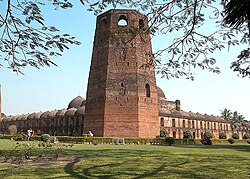Katra Masjid
| Katra Masjid | |
|---|---|
 |
|
| Basic information | |
| Location | Murshidabad, West Bengal, India |
| Geographic coordinates | 24°11′05″N 88°17′17″E / 24.184722°N 88.288056°ECoordinates: 24°11′05″N 88°17′17″E / 24.184722°N 88.288056°E |
| Affiliation | Islam |
| Country | India |
| Year consecrated | 1725 |
| Leadership | Nawab Murshid Quli Khan |
| Website | "URL". |
| Architectural description | |
| Architect(s) | Murad Farash Khan |
| Architectural type | Mosque |
| Architectural style | Islamic |
| Completed | 1724 |
| Specifications | |
| Dome(s) | 5 |
| Minaret(s) | 4 |
| Materials | The grave and mortal remains of Nawab Murshid Quli Khan |
The Katra Masjid (also known as Katra Mosque) is a mosque and the tomb of Nawab Murshid Quli Khan built between 1723 and 1724. It is located in the north eastern side of the city of Murshidabad, in the Indian state of West Bengal. Its importance lies not only as a great centre of Islamic learning but also for the tomb of Murshid Quli Khan, who is buried under the entrance staircase. The most striking feature is the two large corner towers having loopholes for musketry.
At present it is maintained and protected by the Archaeological Survey of India and the Government of West Bengal.
Close to the mosque was a bazaar (market) and Katra means bazaar while Masjid means mosque. So the total sums up to: Katra Masjid or Market Mosque, a mosque in a market.
Murshid Quli Khan on reaching old age, expressed his desire to construct his tomb adjacent to a mosque. He entrusted the responsibility for constructing the mosque to his trusted follower who was an architect, Murad Farash Khan .
The mosque stands on a square plinth. It is a brick built mosque and is surrounded by double storied domed cells, which were built for those who read the Holy Quran in those days, they can also be called a Madrasa. All the rooms can in all accommodate 700 Quran readers. These rooms from a cloister to the huge courtyard in front of these rooms. Four big minars stand at the four corners. These are octagonal in plan and taper upwards. The two towers or the minarets in front of the mosque are 70 feet high and 25 feet in diameter. The whole mosque is quadrangular in shape, the whole mosque has no pillar support but it has been given support by a raised platform below the mosque or by several arches. The mosque has however been destroyed in the 1897 earthquake. Each minar has a winding staircase which leads to the top, one can see a major part of the city of Murshidabad from there. At the two ends of the mosque, two miratets measuring 70 feet high, are still existing to date in a dilapidated condition, they had domes which were destroyed in the 1897 earthquake. In 1780 AD, a traveller name William Hodges wrote that 700 Quran readers lived there in the mosque. Hodges in his book Select Views of India describes it as "a grand seminary of Musalman learning, adorned by a mosque which rises high above all the surrounding buildings".
...
Wikipedia
